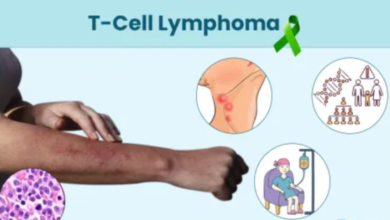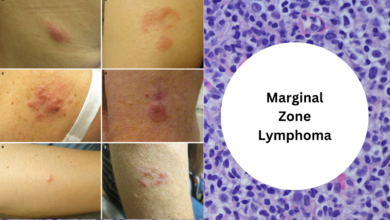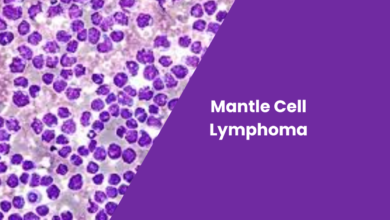Diffuse Large B-Cell Lymphoma (DLBCL)
Understanding DLBCL: Symptoms, Diagnosis, and Treatment

What is Diffuse Large B-Cell Lymphoma (DLBCL)?
Diffuse large B-cell lymphoma (DLBCL) is a type of non-Hodgkin lymphoma, a cancer that originates in the lymphatic system. It’s the most common type of aggressive lymphoma, characterized by rapid growth.
Types of Diffuse Large B-Cell Lymphoma (DLBCL)
While DLBCL is a specific type of lymphoma, it can be further classified based on certain genetic features and clinical characteristics. However, these classifications are primarily used for research purposes and don’t significantly impact treatment decisions.
Symptoms of Diffuse Large B-Cell Lymphoma (DLBCL)
Symptoms of DLBCL can vary but often include:
• Swollen lymph nodes, often in the neck, armpits, or groin
• Fatigue
• Fever
• Night sweats
• Unexplained weight loss
• Persistent cough
• Shortness of breath
• Chest pain
• Abdominal pain
Causes of Diffuse Large B-Cell Lymphoma (DLBCL)
The exact cause of DLBCL is unknown. However, certain factors may increase the risk, such as:
• Weakened immune system: Conditions like HIV/AIDS can weaken the immune system and increase the risk of lymphoma.
• Exposure to certain viruses: Infection with Epstein-Barr virus (EBV) or human T-cell lymphotropic virus (HTLV-1) can increase the risk.
• Family history: A family history of lymphoma can increase the risk.
• Autoimmune disorders: Conditions like rheumatoid arthritis and lupus can increase the risk.
Who Can Suffer from Diffuse Large B-Cell Lymphoma (DLBCL)?
DLBCL can affect people of all ages, but it’s more common in adults.
Diagnostic Tests for Diffuse Large B-Cell Lymphoma (DLBCL)
To diagnose DLBCL, a doctor may use a combination of tests, including:
• Physical exam: To check for swollen lymph nodes and other abnormalities.
• Blood tests: To check for abnormalities in the blood cells.
• Biopsy: A tissue sample is removed from a swollen lymph node or other affected tissue and examined under a microscope.
• Imaging tests: CT scans, MRIs, and PET scans can help determine the extent of the cancer.
Stages of Diffuse Large B-Cell Lymphoma (DLBCL)
DLBCL is typically staged using the Ann Arbor staging system, which considers the extent of the disease and the involvement of lymph nodes.
Treatment of Diffuse Large B-Cell Lymphoma (DLBCL)
The treatment for DLBCL depends on the stage and overall health of the patient. Common treatment options include:
• Chemotherapy: To kill cancer cells throughout the body.
• Immunotherapy: To boost the body’s immune system to fight cancer cells.
• Targeted therapy: To target specific molecules involved in cancer cell growth.
• Stem cell transplantation: To replace damaged bone marrow with healthy stem cells.
Diet and Diffuse Large B-Cell Lymphoma (DLBCL) Prevention
While a healthy diet cannot directly prevent DLBCL, it can contribute to overall health and strengthen the immune system. Here are some general dietary recommendations:
• A balanced diet: A diet rich in fruits, vegetables, and whole grains can help.
• Limit processed foods and sugary drinks: These can contribute to weight gain and other health problems.
• Maintain a healthy weight: Obesity is linked to an increased risk of certain cancers.
Overall Survival Rate of Diffuse Large B-Cell Lymphoma (DLBCL)
• The overall survival rate for DLBCL has improved significantly in recent years due to advancements in treatment. However, it varies depending on factors such as the stage of the disease and the patient’s overall health. Early diagnosis and aggressive treatment are crucial for a better prognosis.
Doctor to Consult
• A hematologist-oncologist is the best doctor to consult for DLBCL.
Diseases Associated with Diffuse Large B-Cell Lymphoma (DLBCL)
• While DLBCL is not directly associated with other specific cancers, it can be linked to certain viral infections and immune system disorders, such as:
• Epstein-Barr virus (EBV)
• Human immunodeficiency virus (HIV)
• Autoimmune disorders
How to Prevent Diffuse Large B-Cell Lymphoma (DLBCL)
• While there’s no guaranteed way to prevent DLBCL, maintaining a healthy lifestyle can reduce the risk of certain factors that may contribute to the disease:
• Limit exposure to radiation and certain chemicals: Exposure to these substances can increase the risk of certain types of cancer.
• Maintain a healthy weight: Obesity is linked to an increased risk of certain cancers.
• Regular check-ups: Regular check-ups can help detect any abnormalities early on.
• Healthy lifestyle: A healthy lifestyle, including a balanced diet and regular exercise, can help boost the immune system.





